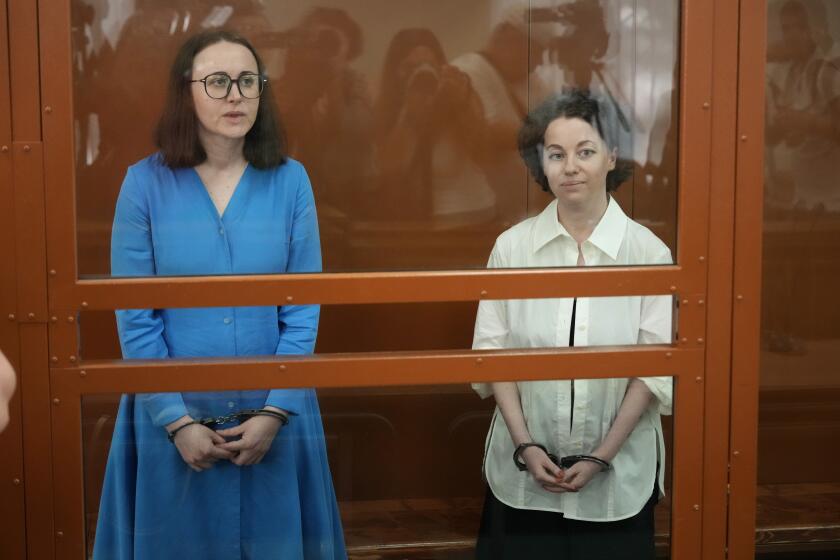A Big Gamble in the Making
Steven Spielberg, Jeffrey Katzenberg and David Geffen have got guts.
When they formed DreamWorks SKG in 1994, it was the first new movie studio created in Hollywood in more than 50 years. Now, they’re trying for another audacious first: a cartoon for adults.
DreamWorks’ first animated feature film, due in theaters Dec. 18, will have “no princess, no singing teapots, no singing animals and no checking with marketing to see if they could sell it,” said Walter Parkes, the studio’s production chief.
The biblical tale of the life of Moses, titled “The Prince of Egypt,” will have a line of collectible figures and books, but “no burning bush night lights, no Red Sea shower curtains that split in the middle, no 40-days-in-the-desert water bottles” or other merchandise tie-ins, said Sandra Rabins, one of the film’s producers.
And if DreamWorks gets its wish, the epic project known around Hollywood by the nickname “P.O.E.” will be rated not a kid-friendly G, but PG (carrying this warning: “Some material may not be suitable for children.”).
Guts? The DreamWorks folks have certainly got them. But their deliberate departure from formulas that have ensured the success of earlier animated musicals has prompted some to ask: Have they lost their minds?
Many movie industry insiders, who are watching the project with a mixture of skepticism and awe, agree that “The Prince of Egypt” has one key thing going for it: Katzenberg. The former chairman of Walt Disney Studios, whose shepherding of “Beauty and the Beast” and other Disney animated films was widely seen as brilliant, considers this project his baby. And that alone discourages people from predicting its failure.
“One thing you can bank on is Jeffrey is a good movie-maker,” said one executive who asked not to be named.
But to succeed, DreamWorks must do something daunting: Change the moviegoing habits of American adults, many of whom see animation as kids’ stuff. Perhaps even more challenging, given this movie’s religious plot line, DreamWorks must convince grown-ups that animation can be serious without being preachy. “The danger is if they treat it as too self-important,” said another industry observer, who believed that the fledgling studio made that mistake with “Amistad,” Spielberg’s 1997 drama about slavery. “They misstepped drastically when they put it in the ‘important’ category and ‘good medicine’ category. . . . [This time] if they come off as the religious zealot poster child, that’s going to keep a lot of people away.”
Already, eight months before its premiere, DreamWorks has begun maneuvering to position the film, whose budget has been reported in the $60 million-$70 million range. Last month at ShoWest, the annual convention of theater owners in Las Vegas, the studio unveiled a promotional reel that portrayed “The Prince of Egypt” as the ultimate action-adventure story.
“In a world of power and mystery, they were the sons of a king,” a narrator says of Moses and Ramses while, on screen, animated slaves build pyramids and hand-drawn warriors race chariots. “Two brothers, united by friendship. One was born to rule. The other was chosen to lead. Destiny would make them enemies. Feel the power of the greatest adventure of all time!”
For weeks, DreamWorks publicists have been leading journalists on the “P.O.E.” tour--a stroll through the hallways of DreamWorks’ Glendale animation headquarters. Lining the walls are charts and sketches that introduce the film’s characters (with voices by such stars as Michelle Pfeiffer and Ralph Fiennes), reveal the inspiration for the film’s look (Claude Monet for backgrounds, David Lean for composition) and even map out an “emotional beatboard” to show how the audience is expected to react to each scene.
“It isn’t your father’s animated movie,” Terry Press, the executive who heads up DreamWorks’ strategic marketing, boasts as she points out a huge swarm of computer-generated locusts (7 million of them), the parting of the Red Sea (a complex, four-minute scene that took 12 people three years to create) and the spooky rendering of the death of the first born. But she admits that the movie presents a marketing challenge.
“I’m the first person to say the movie’s a huge risk. People think of animated movies as things that come with Happy Meals,” she said. “Jeffrey’s theory is that animation is a tool to tell stories. That doesn’t mean you just have to tell fairy tales. But I’m not kidding myself. . . . Getting people there will be hard.”
Meanwhile, the studio has been courting religious leaders, inviting over 350 to see parts of the film and make suggestions. On more than one occasion, the film’s producers say, such input has led them to rewrite a scene. For example, Evangelical Christian leaders requested that Moses refer to “blood upon the door” instead of “a mark upon the door” when describing God’s instructions before the 10th plague.
“There was no reason not to accommodate them,” said producer Penney Finkelman Cox, though she said actor Val Kilmer, who is the voice of Moses, had already recorded the track, which had to be redone. “For them, the significance they placed on the moment was heightened [by the change]. That happened as many as 50 times, especially on the dialogue that was signified as coming from God.”
DreamWorks is coming up with study guides to accompany the film--a different one for each religious community. And its production team is still finalizing some of the film’s central elements, such as how to create the voice of God.
“The original vision was that God’s voice was a compilation of all the people he ever cared about. But when we tried to execute that, we got the voice of Hal the computer,” said Finkelman Cox. Now, the plan is to combine voice, sound effects and music to represent God speaking, she said. “Our ambition is to remove the gender. We don’t want it to sound like James Earl Jones.”
The idea of adults going to animated films without children is not without precedent. Industry analysts agree that Disney’s “The Lion King” (1994) could not have grossed $313 million domestically without attracting a fair number of grown-ups. And 20th Century Fox’s “Anastasia,” which broke the Disney animation stronghold last year by grossing a respectable $58 million to date, is believed to have drawn not just kids, but a significant number of teenagers and young women in their early 20s.
There is some speculation, moreover, that animated musicals can draw moviegoers who once loved live-action musicals (none of which are being made these days). Says Press: “You can’t make live-action musicals anymore. People roll their eyes. But people will buy a genre in animation that they won’t in live action.”
But again, DreamWorks is gambling by largely omitting another time-tested ingredient: humor. Disney has successfully used humor to accomplish what might be called bilevel storytelling--the genie in “Aladdin,” for example, who amuses the kiddies with slapstick antics while also delivering sarcastic, suggestive zingers that entertain adults. The makers of “The Prince of Egypt” appear to be going for a more singular, sophisticated vision--in part because the tale they are telling doesn’t easily lend itself to jokes.
“There’s not as much humor as you’re used to” in animation, Finkelman Cox said. “We tried. We had cute sheep. We wanted Ramses to have cats. We had it all. . . . But we found we couldn’t impose humor on this story. We couldn’t put in talking gargoyles. It could be offensive.”
According to his associates, Katzenberg is not merely hoping for a PG rating. He has said that if he doesn’t get one--if, by chance, the Motion Picture Assn. of America rates the film a G--he will appeal.
“This is not a movie that parents can drop their kids off at for the afternoon. Parents need to be prepared to answer tough questions,” Rabins, the producer, said soberly. “Is God an angry God? Why does he allow slavery? Why does he kill? This is not a movie for toddlers.”
Press, meanwhile, makes a prediction about who the movie is for: “This movie will bring out people who think movies have fallen into Sodom and Gomorrah. For every 18-year-old boy I don’t get, I may get somebody who’s been so turned off by Hollywood that they don’t go to the movies at all.”
Think twice before betting against her. At ShoWest, where theater owners were shown the film’s first seven minutes, exhibitors like George Keloff Sr., who runs a three-screen movie house in rural Colorado, said they couldn’t wait to see the rest.
“In our area, which is conservative Christian, it’ll do great,” Keloff predicted. “It’s a great Christmas movie.”
More to Read
The biggest entertainment stories
Get our big stories about Hollywood, film, television, music, arts, culture and more right in your inbox as soon as they publish.
You may occasionally receive promotional content from the Los Angeles Times.






